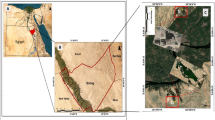Abstract
A study was conducted to determine the suitability of using selected aquatic dipterian larvae for biomonitoring bioassays. The organisms included a member of the biting midge family that was identified as Culicoides furens and a member of the non-biting midge family, identified as Chironomus plumosus. Median lethal toxicity tests were conducted to observe the variation between metal sensitivities between the two larval forms and how variations in temperature could affect the experimental setup. Nine heavy metals were used in the study. It was observed that the 96 h LC50 (in mg/L) for the different metals was found to be Zn-16.21 (18.55 ± 13.87); Cr-0.96 (1.08 ± 0.84); Ag-4.22 (6.87 ± 1.57); Ni-0.42 (0.59 ± 0.25); Hg-0.42 (0.59 ± 0.25); Pb-16.21 (18.31 ± 14.11); Cu-42.24 (45.18 ± 39.30); Mn-4.22 (7.19 ± 1.25); Cd-0.42 (0.59 ± 0.25) for the Chironomus plumosus and Zn-4.22 (6.56 ± 1.88); Cr-0.42 (0.54 ± 0.30); Ag-0.42 (0.54 ± 0.30); Ni-0.42 (0.54 ± 0.30); Hg-0.04 (0.07 ± 0.01); Pb-0.42 (0.54 ± 0.30); Cu-42.24 (45.18 ± 39.30); Mn-4.22 (6.56 ± 1.88); Cd-0.42 (0.54 ± 0.30) in the case of the Culicoides furens. With temperature as a variable the LC50 values were observed to increase from 2.51 mg/L at 10°C to 4.22 ppm at 30°C and to reduce slightly to 3.72 mg/L at 35°C as seen in the case of Zn. It was also observed that at 40°C thermal toxicity and chemical toxicity overlapped as 100% mortality was observed in the controls. This trend was observed in all metals for both C. plumosus and C. furens. Thus indicating temperature played an important role in determining LC50 values of toxicants.
Similar content being viewed by others
References
Anderson RL, Walbridge CT, Fit JT (1980) Survival growth of Tanytarsus dissimilis (Chironomusae) exposed to copper, cadmium, zinc, and lead. Arch Environ Contam Toxicol 9:329–335
Baudouin MF, Scoppa P (1974) Acute toxicity of various metals to freshwater zooplankton. Bull Environ Contam Toxicol 12:745–751
Cairns J, Scheier A (1958) The effects of temperature hardness of water upon the toxicity of zinc to the pond snail, Physa heterostropha (Say). Notulae Naturae Acad Nat Sci 308:1
De Nicola GM, Gambardella C, Guarino SM (1992) Interactive effects of cadmium and zinc pollution on PGI and PGM polymorphisms in Idotea baltica. Mar Poll Bull 24:619–621
Eisler R, Hennekey RJ (1977) Acute toxicities of Cd2+, Cr6+, Hg2+, Ni2+, Zn2+ to esturine macrofauna. Arch Environ Contam Toxicol 6:315–323
Griffiths RW (1991) Environmental quality assessment of the St. Clair River as reflected by the distribution of benthic macroinvertebrates in 1985. Hydrobiologia 219:143–164
Halpern M, Gasith A, Broza M (2002) Does the tube of a benthic Chironomuss larva play a role in protecting its dweller against chemical toxicants? Hydrobiologia 470:49–55
Khangarot BS, Ray PK (1987) Studies on the acute toxicity of copper mercury alone in combination to the common guppy Poecilia reticulata (Peters). Arch Hydrobiol Stuttigart 110(2):303–314
Khangarot BS, Ray PK (1989) Sensitivity of midge larvae Chironomus tentans Fabricus (Diptera Chironomusae) to metals. Bull Environ Contam Toxicol 42:325–330
Leland HV, Kuwabara JS (1984) Trace metals. In: Rand GM, Petrocelli SR (eds) Fundamentals of aquatic toxicology. Hemisphere publishing, Washington, p 134
MacInnes JR, Calabrese A (1978) Response of embryos of the American oyster Crassostrea virginica, to metals at different temperatures. In: MacInnes JR, Calabrese A (eds) Physiology and behaviour of marine organisms. 12th Eur Mar Biol Symp, Oxford. Pergamon Press, pp 195–202
MacInnes JR, Calabrese A (1979) Combined effects of salinity, temperature and copper on embryos and early larvae of the American oyster Crassostrea virginica. Arch Environ Contam Toxicol 8:553–562
McLusky DS, Bry V, Campbell R (1986) The effects of temperature salinity on the toxicity of metals to marine estuarine invertebrates. Oceanogra. Mar Biol Annu Rev Winchester 24:481–520
Milani D, Reynoldson TB, Borgmann U, Kolasa J (2003) The relative sensitivity of four benthic invertebrates to metals in spiked-sediment exposures application to contaminated field sediment. Environ Toxicol Chem 22:845–854
Rao DS, Saxena AB (1981) Acute toxicity of mercury, zinc, lead, cadmium manganese to Chironomus sp. Int J Environ Stud 16:225–226
Rehwoldt R, Lasko L, Shaw C, Wirhowski E (1973) The acute toxicity of some metal ions toward benthic organisms. Bull Environ Contain Toxicol 10:291–294
Author information
Authors and Affiliations
Corresponding author
Rights and permissions
About this article
Cite this article
Vedamanikam, V.J., Shazilli, N.A.M. Comparative Toxicity of Nine Metals to Two Malaysian Aquatic Dipterian Larvae with Reference to Temperature Variation. Bull Environ Contam Toxicol 80, 516–520 (2008). https://doi.org/10.1007/s00128-008-9413-x
Received:
Revised:
Accepted:
Published:
Issue Date:
DOI: https://doi.org/10.1007/s00128-008-9413-x




